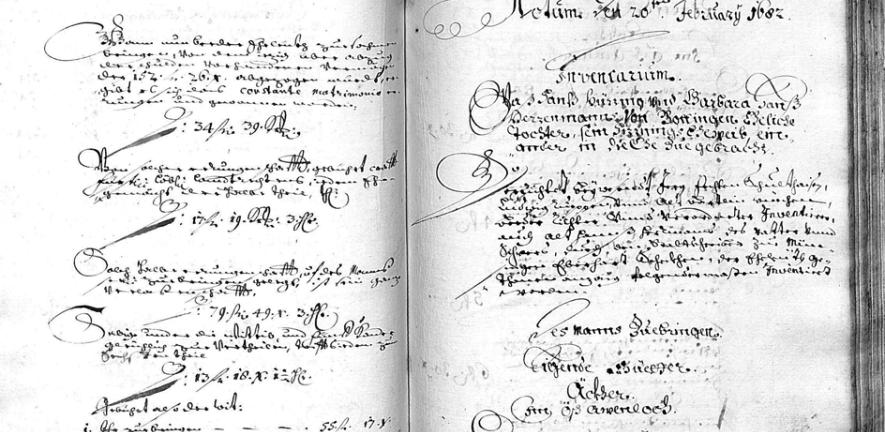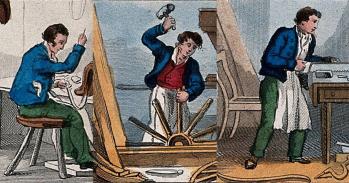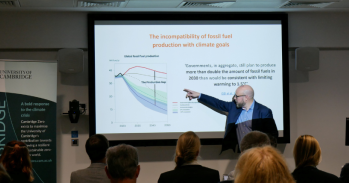
Personal inventories spanning three centuries are helping researchers unlock the mysteries of how economies edge towards growth and prosperity.
Personal inventories spanning three centuries are helping researchers unlock the mysteries of how economies edge towards growth and prosperity.
More work meant more earnings, more earnings meant people could buy more consumer goods, and this spurred producers to innovate and expand.
Professor Sheilagh Ogilvie
‘One cabbage-spoon, a new dung-barrow, two badger-skins and a half share of an old pregnant mare…’ – so read the belongings of Hanss Hürning on the occasion of his marriage in 1682 to Barbara, owner of ‘nine white bonnets, a new scarlet over-bodice, a small spinning-wheel and a three-year-old red-brown cow.’
Many of us today would find it incredibly difficult to list absolutely everything we own, but in the southwest German territory of Württemberg until 1900 such lists were drawn up over hundreds of years for most newly-married brides and bridegrooms and bereaved widows and widowers.
From clothing to kitchen goods, land to luxuries, the entire contents of homes and businesses were inventoried for inheritance purposes, down to the last oaken water-vat or sack of dried apple slices. And, remarkably, many thousands of these Württemberg inventories survive today.
Now a team of researchers, led by Professor Sheilagh Ogilvie, an economic historian at the University of Cambridge, and funded by the Economic and Social Research Council, is systematically studying these unrivalled documents for the first time to chart the history of how poor economies improve living standards. They hope that understanding the rise in human wellbeing in European economies over past centuries could hold lessons for developing economies today.
Reconstructing history
Professor Ogilvie first stumbled across the Württemberg inventories as a graduate student 30 years ago: “Ledger upon ledger contained lists that in isolation were fascinating but, together, offered an incredible community-wide compendium of who owned what, and how this changed from marriage to death and with successive generations.”
Although inventories survive elsewhere, those in Württemberg are exceptionally detailed, covering marriage and death, women and men, poor and rich, mansions and mousetraps.
For the past three years, the Cambridge researchers have been painstakingly examining each handwritten document, compiling its contents in a vast database, and carrying out multivariate statistical analyses. In so doing, the team is reconstructing 300 years of economic history, from 1600 to 1900, for two Württemberg communities – the village of Auingen on the Schwäbische Alb and the small town of Wildberg in the Black Forest. In 2013, the completed database will be deposited in the UK Data Archive, which is open to public access.
What really brings the inventories alive is information generated by a previous project, led by Professor Ogilvie and funded by the Leverhulme Trust, which created a full demographic reconstruction of the same two communities. Family trees, fertility and mortality are linked to occupational background, wealth, farm size, household structure, literacy and social networks, and now, through the new project, to individuals’ belongings.
To date, 28,000 handwritten folios have been analysed, representing 460,000 separate items of property and their monetary values. For over 3,000 individuals, the researchers now know who they were and what they owned, their gender, age and marital status, place of origin, occupation, credit relationships and office-holding, whether or not they could sign their name, and who were their family members and heirs.
An ‘Industrious’ Revolution in the making?
This wealth of information is opening a window on how market consumption affects the economy. In fact, it’s the most comprehensive attempt yet to investigate the theory of the ‘Industrious’ Revolution – the idea that the Industrial Revolution was preceded by a time when a growing desire for consumer goods spurred changes in households’ time allocation and productivity.
“Aspirations for the latest fashions, furnishings and stimulants motivated people to shift time from leisure and do-it-yourself to income-earning work, creating a virtuous circle,” explained Professor Ogilvie. “More work meant more earnings, more earnings meant people could buy more consumer goods, and this spurred producers to innovate and expand.”
Up to now, the Industrious Revolution theory has relied almost exclusively on English and Dutch records before circa 1750. But many European economies – such as Germany – were much poorer and slower-growing than the north Atlantic seaboard.
What held Germany back? Professor Ogilvie’s past research has pointed towards the dominance of guilds and merchant associations in resisting changes that threatened their monopolies. Guilds erected barriers against even the simplest commercial innovations such as peddling or rural craftwork that brought goods cheaply to poor consumers. Governments and elites tried to control what ordinary people could consume.
“It might be argued that such prohibitions were merely futile gestures, were it not for the fact that people at the time took them quite seriously,” said Professor Ogilvie. “Social norms about the appropriate quantity, quality and style of consumption for particular social groups were enforced with sumptuary penalties and public shaming, even for inviting ‘too many’ guests to your wedding or wearing excessively wide trousers.” [see panel]
This reduced people’s ability to buy new goods and their incentive to work more hours to afford them. The German Industrious Revolution was held back until guilds, merchant associations and sumptuary laws broke down, after about 1800.
For the Cambridge project, this means that small changes in what people owned – even the first coffee cup to appear in someone’s inventory – are significant because they could indicate the beginnings of an Industrious Revolution.
“We encountered our first coffee cup in an inventory of 1718,” said Professor Ogilvie. “After that we expected that a fashion for coffee and its associated equipment would take off, but instead there was no further mention until 1733. We have just found our third coffee cup in 1739. We know that they become common by the 1750s so we are on tenterhooks for the next couple of months while we work our way through the 1740s.”
With their gigantic database at their fingertips, the team can ask fine-grained questions such as who started using coffee cups, calico dresses, or any other trend. Were they rich or poor, educated or illiterate, male or female, locals or migrants? The team can trace how rapidly any trend spread and whether – as the Industrious Revolution predicts – it coincided with other household changes.
Tracing such changes in history is important for understanding present-day developing economies, as Professor Ogilvie explained: “We think that household-level changes in consumer behaviour and literacy are good predictors of economic development, lower child mortality, a better position for women, and higher human wellbeing. Now we have a powerful tool to describe these changes accurately – and to explain them.”
For more information, please contact Professor Sheilagh Ogilvie (sheilagh.ogilvie@econ.cam.ac.uk) at the Faculty of Economics or visit www.econ.cam.ac.uk/Ogilvie_ESRC/index.html
The wrong trousers
How would you like the government or your neighbours to tell you how to dress?
Traditional societies often have informal customs about what people (especially women) are allowed to wear. But some go further and actually pass laws about it. This is what happened in many parts of pre-industrial Europe. German states, for example, passed at least 1,350 laws regulating clothing between 1244 and 1816.
You might think such laws were unenforceable. But in early modern Germany they were enforced. In 1662, for instance, a Württemberg community court reprimanded an unmarried weaver’s son “on account of his very wide trousers, a fashion that it is unfitting for him to wear”, fined him about two weeks’ wages, and warned him that “if he should again put on trousers of this fashion, they shall, by virtue of the Princely Command, be confiscated.”
In 1708, another Württemberg village court forbade Magdalena Schöttlin, a local weaver’s wife, to wear “her excessively large neckerchief, which she is accustomed to wearing above her station.” When Magdalena went on wearing it, she was summoned before the court and fined the equivalent of 11 days’ wages for a local maidservant.
Dress laws couldn’t totally stop people from doing new things, of course. But they increased the costs and risks of participating in an Industrious Revolution – especially for women, young people and the poor. It may not be a coincidence that in England and The Netherlands, the ‘miracle economies’ of pre-industrial Europe, dress laws were abolished around 1600, just before their Industrious Revolutions really began to take off.
This work is licensed under a Creative Commons Licence. If you use this content on your site please link back to this page.





